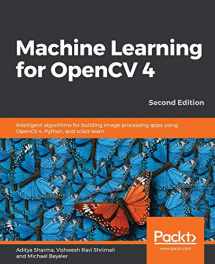
Machine Learning for OpenCV 4- Second Edition
Book details
Summary
Description
A practical guide to understanding the core machine learning and deep learning algorithms, and implementing them to create intelligent image processing systems using OpenCV 4
Key Features- Gain insights into machine learning algorithms, and implement them using OpenCV 4 and scikit-learn
- Get up to speed with Intel OpenVINO and its integration with OpenCV 4
- Implement high-performance machine learning models with helpful tips and best practices
OpenCV is an opensource library for building computer vision apps. The latest release, OpenCV 4, offers a plethora of features and platform improvements that are covered comprehensively in this up-to-date second edition.
You'll start by understanding the new features and setting up OpenCV 4 to build your computer vision applications. You will explore the fundamentals of machine learning and even learn to design different algorithms that can be used for image processing. Gradually, the book will take you through supervised and unsupervised machine learning. You will gain hands-on experience using scikit-learn in Python for a variety of machine learning applications. Later chapters will focus on different machine learning algorithms, such as a decision tree, support vector machines (SVM), and Bayesian learning, and how they can be used for object detection computer vision operations. You will then delve into deep learning and ensemble learning, and discover their real-world applications, such as handwritten digit classification and gesture recognition. Finally, you'll get to grips with the latest Intel OpenVINO for building an image processing system.
By the end of this book, you will have developed the skills you need to use machine learning for building intelligent computer vision applications with OpenCV 4.
What you will learn- Understand the core machine learning concepts for image processing
- Explore the theory behind machine learning and deep learning algorithm design
- Discover effective techniques to train your deep learning models
- Evaluate machine learning models to improve the performance of your models
- Integrate algorithms such as support vector machines and Bayes classifier in your computer vision applications
- Use OpenVINO with OpenCV 4 to speed up model inference
This book is for Computer Vision professionals, machine learning developers, or anyone who wants to learn machine learning algorithms and implement them using OpenCV 4. If you want to build real-world Computer Vision and image processing applications powered by machine learning, then this book is for you. Working knowledge of Python programming is required to get the most out of this book.
Table of Contents- A Taste of Machine Learning
- Working with Data in OpenCV
- First Steps in Supervised Learning
- Representing Data and Engineering Features
- Using Decision Trees to Make a Medical Diagnosis
- Detecting Pedestrians with Support Vector Machines
- Implementing a Spam Filter with Bayesian Learning
- Discovering Hidden Structures with Unsupervised Learning
- Using Deep Learning to Classify Handwritten Digits
- Ensemble Methods for Classification
- Selecting the Right Model with Hyperparameter Tuning
- Using OpenVINO with OpenCV
- Conclusion


We would LOVE it if you could help us and other readers by reviewing the book
Book review



